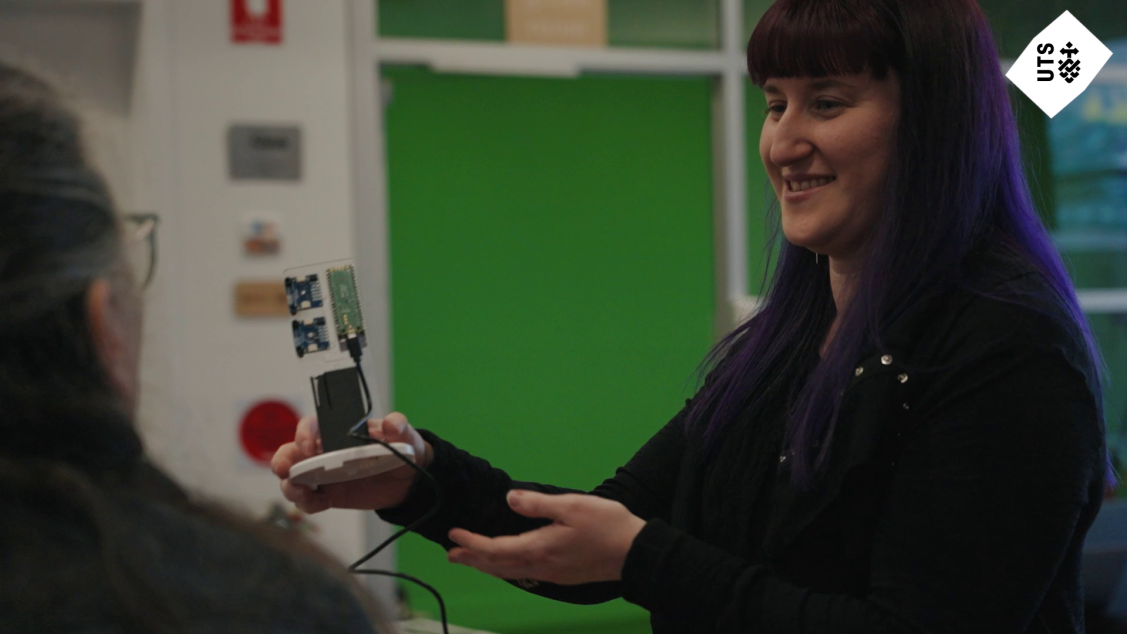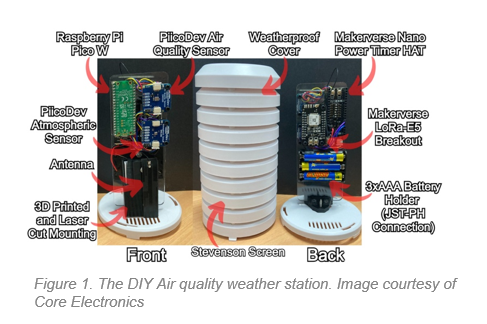Lake Macquarie City Council’s DIY air quality weather station
| Dates | February 2022 - ongoing |
| Locations | Swansea |
| Issue | Bushfire and hazard reduction burn smoke, road traffic pollution |
| Sensing devices | 10 custom DIY devices co-developed by Lake Mac FabLab and Core Electronics |
| Data measured | Temperature, humidity, pressure, CO2, VOC |
| Communications technology | 4GLoRaWAN (The Things Network) |
“Our initiative empowers communities to monitor and understand local air quality using accessible, low-cost technology. Now anyone, anywhere is able to build their own air quality monitoring station using the opensource design and step-by-step instructions that we developed through the OPENAIR project.”

Lake Macquarie City Council have been experimenting with smart low-cost air quality sensing since 2018. For OPENAIR, Council wanted to do something a bit different. Working through their new FabLab, they developed a DIY sensing device, accompanying technical support materials, and a workshop program for highschoolers and adults. The aim was to actively involve community members with IoT technology and data in a fun, accessible and very hands on way. As people built, programmed and activated their DIY air quality monitoring devices they developed first-hand knowledge of smart sensing technology. This improved their broader technical and data literacy and increased their understanding of and trust in other smart sensing activities managed by Council.
Why did Council focus on this issue?
Council’s Community Strategic Plan supported the project by emphasising climate resilience, which guided the focus on air quality and heat. The plan also highlighted the importance of technology and data literacy for the community. Council had also just launched a new FabLab and OPENAIR provided a focus and support for program development. The aim was to engage and empower community and create a conversation around smart technology and data.
Who was involved in the planning and delivery of the pilot?
The project was led primarily by one staff member, the FabLab Lead, who sits within Council’s Libraries Division. Support was provided by a staff member from the Asset Optimisation team, with shared interest in technology and sustainability. The project had the support of the Council Executive.
The project was co-developed by Council with Core Electronics, a Newcastle-based small technology business, with an aligned commitment to DIY and open source technology. Core Electronics contributed significantly to design and development of the DIY device and support materials.
The technology
The DIY air quality sensing device measures ambient CO2 and VOCs using ultra-low-cost sensors with indeterminate performance (i.e. no detailed information available). Data quality was a low priority because the focus was more on education and engagement. The device was designed using open technology principles, in line with the global FabLab charter. Low-cost compact components were combined into a modular design. Any part may be substituted for similar alternatives, supporting a highly flexible approach to opensource technology development.
The device utilised Council’s existing LoRaWAN communications network (The Things Network). It is also able to connect via Wi-Fi, which supports people borrowing it through the library and deploying it at home. IoT and data platforms were selected for openness, accessibility and cost effectiveness.

Sensing device deployment
Workshop participants were encouraged to consider deployment locations that would be meaningful to them and that they could tell a story about. The aim was to empower participants to explore air quality on their own terms. Council was less concerned with specific deployment locations or data capture, and more focused on community engagement and data literacy.
Challenges and lessons learned
Technical challenges
The LoRaWAN gateway was damaged by a bird a day before the main workshop, resulting in a last-minute (unsuccessful) effort to try and store data on the devices for manual download. The workshop went ahead and made use of historical data for teaching purposes. Devices were subsequently activated once the LoRaWAN issue was fixed.
The core aim of the workshop was to teach participants about smart technology, how data is collected, and some of the complexity of data management and interpretation. Hence, despite the technical challenges, workshop participants had a rewarding and positive experience. They learned firsthand about practical challenges and the importance of learning from failure, adapting and trying again.
Resourcing constraints
Staffing and time allocation for the initial pilot delivery was limited, which may have played a part in the technical challenges experienced. A lesson for Council has been the importance of allocating sufficient time and resources for thorough testing of technology prior to a workshop, as well as having established and tested backup options in place to avoid last minute failure.
Resourcing constraints during phase one also limited the extent of the engagements to a single workshop. With additional staff capacity and operational budget at the FabLab, phase two of the initiative is able to feature extensive multi-session engagements for schools, with accompanying curriculum-matched lesson plans.
Data and insights
About the data
Device performance was initially assessed by the design team. It was noted that data reporting was consistent and that the data ‘made sense at a basic level of operation’ (e.g. coherent data packets were received at regular intervals and were interpreted to give environmental readings within expected ranges for the conditions). This was felt to be adequate for supporting the needs of an entry-level data literacy workshop.
To date, the ten devices built have not collected meaningful air quality or heat data. They were activated in a single location for around twenty-four hours, following the pilot workshop in July 2023. This has been framed as an initial successful proof of concept.
The project procured the parts required to build up to thirty DIY sensing devices and the original ten are still available for reuse. Moving into phase two of the project, Council aims to work with high school students and community members to deploy devices and collect useable data for up to two months.
Data sharing
Air quality data collected during the initial pilot phase was very limited and has not been shared. However, Council intends to share data with the public in phase two (assuming that participants consent to do so). The intention is to connect live data streams to data.nsw.gov.au and data.gov.au and there is interest in integrating with the NSW Government’s OPENAIR data platform, which is hosted within the SEED portal. Council’s Data Sharing Policy commits the organisation to open data sharing wherever it is possible and appropriate.
The initial pilot project has shared knowledge and IP via opensource publication. All aspects of the hardware configuration and code for building and operating the DIY device have been published in accordance with opensource protocols, on the Core Electronics website and on GitHub.
Creating impact
“It’s done what a pilot should do. We tested stuff. We had some failures. We learned from them. And now we’ve come out into phase two where it lives on. From the beginning we wanted stuff that would live on and be used by multiple people.”
– Lake Mac FabLab Lead

The OPENAIR pilot project has resulted in the following positive impacts:
Successful technology and data literacy engagement
Council’s OPENAIR pilot initiative was focused on technology and data literacy engagements with community and saw delivery of one community workshop where ten devices were assembled and activated.
Supporting Council’s future smart sensing activities
The engagement has helped reduce community fear about smart technology and built understanding, trust and enthusiasm for what is possible. It is hoped that this contributes to broader community support for future smart sensing activities that Council might undertake.
Open-source uptake
The pilot project successfully created an open-source DIY air quality sensing device that other people have now built and deployed, independently of Council, in different locations. Posts on troubleshooting forums provide evidence that this is happening.
Internal collaboration and knowledge sharing
Interdepartmental collaboration at Council has resulted in transfer of technical knowledge and insights from the FabLab to the Asset Optimisation team, benefitting future smart technology procurement and operations by Council.
Initial success has leveraged ongoing funding
The success of the pilot initiative contributed to Council support for additional FabLab staff in 2024, and operational budget for an expanded program of workshops and engagements.
Looking ahead
A second phase of engagements is launching in 2025, made possible by funding renewal for the Lake Mac FabLab from Council in 2024. A high school program has been developed for May and June 2025, with multiple sessions, curriculum matched lesson plans, and plans to support students with the capture up to two months of air quality data at locations of their choice. An adult program, delivered through the FabLab, is also planned for later in the year.
Once phase two engagements are underway, Council will promote their work to the wider public and through local government forums. It is hoped that this will drive further uptake of the opensource resources by councils, schools and individuals around the country.